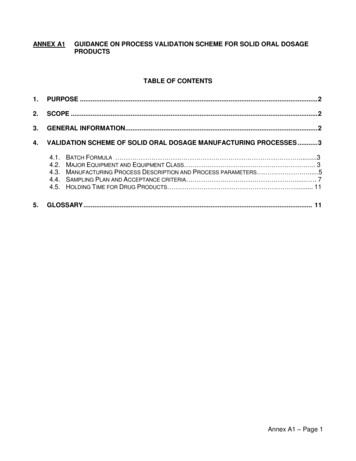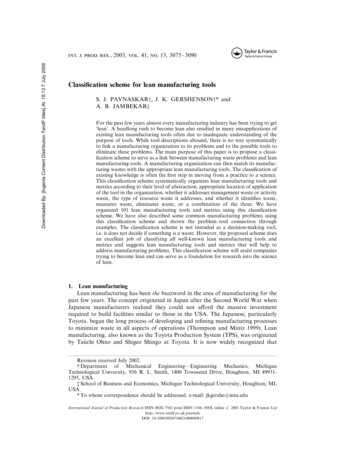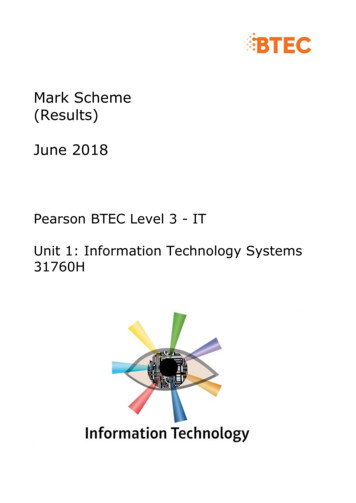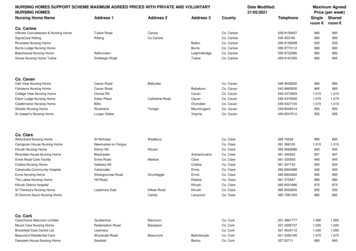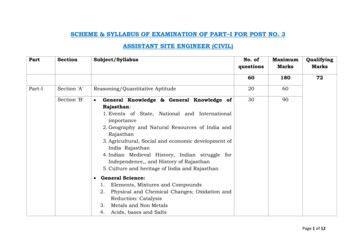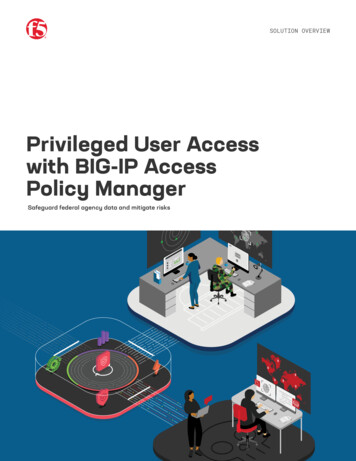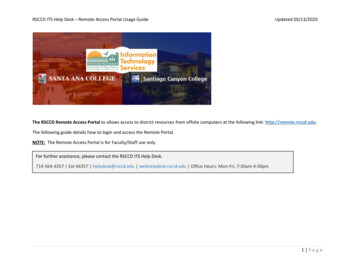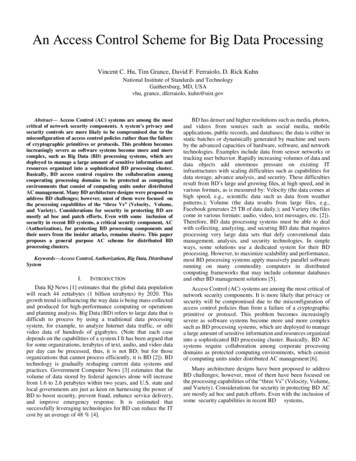
Transcription
An Access Control Scheme for Big Data ProcessingVincent C. Hu, Tim Grance, David F. Ferraiolo, D. Rick KuhnNational Institute of Standards and TechnologyGaithersburg, MD, USAvhu, grance, dferraiolo, kuhn@nist.govAbstract— Access Control (AC) systems are among the mostcritical of network security components. A system’s privacy andsecurity controls are more likely to be compromised due to themisconfiguration of access control policies rather than the failureof cryptographic primitives or protocols. This problem becomesincreasingly severe as software systems become more and morecomplex, such as Big Data (BD) processing systems, which aredeployed to manage a large amount of sensitive information andresources organized into a sophisticated BD processing cluster.Basically, BD access control requires the collaboration amongcooperating processing domains to be protected as computingenvironments that consist of computing units under distributedAC management. Many BD architecture designs were proposed toaddress BD challenges; however, most of them were focused onthe processing capabilities of the “three Vs” (Velocity, Volume,and Variety). Considerations for security in protecting BD aremostly ad hoc and patch efforts. Even with some inclusion ofsecurity in recent BD systems, a critical security component, AC(Authorization), for protecting BD processing components andtheir users from the insider attacks, remains elusive. This paperproposes a general purpose AC scheme for distributed BDprocessing clusters.Keywords—Access Control, Authorization, Big Data, DistributedSystemI.INTRODUCTIONData IQ News [1] estimates that the global data populationwill reach 44 zettabytes (1 billion terabytes) by 2020. Thisgrowth trend is influencing the way data is being mass collectedand produced for high-performance computing or operationsand planning analysis. Big Data (BD) refers to large data that isdifficult to process by using a traditional data processingsystem, for example, to analyze Internet data traffic, or editvideo data of hundreds of gigabytes. (Note that each casedepends on the capabilities of a system.I It has been argued thatfor some organizations, terabytes of text, audio, and video dataper day can be processed, thus, it is not BD; but for thoseorganizations that cannot process efficiently, it is BD [2]). BDtechnology is gradually reshaping current data systems andpractices. Government Computer News [3] estimates that thevolume of data stored by federal agencies alone will increasefrom 1.6 to 2.6 petabytes within two years, and U.S. state andlocal governments are just as keen on harnessing the power ofBD to boost security, prevent fraud, enhance service delivery,and improve emergency response. It is estimated thatsuccessfully leveraging technologies for BD can reduce the ITcost by an average of 48 % [4].BD has denser and higher resolutions such as media, photos,and videos from sources such as social media, mobileapplications, public records, and databases; the data is either instatic batches or dynamically generated by machine and usersby the advanced capacities of hardware, software, and networktechnologies. Examples include data from sensor networks ortracking user behavior. Rapidly increasing volumes of data anddata objects add enormous pressure on existing ITinfrastructures with scaling difficulties such as capabilities fordata storage, advance analysis, and security. These difficultiesresult from BD’s large and growing files, at high speed, and invarious formats, as is measured by: Velocity (the data comes athigh speed, e.g., scientific data such as data from weatherpatterns.); Volume (the data results from large files, e.g.,Facebook generates 25 TB of data daily.); and Variety (the filescome in various formats: audio, video, text messages, etc. [2]).Therefore, BD data processing systems must be able to dealwith collecting, analyzing, and securing BD data that requiresprocessing very large data sets that defy conventional datamanagement, analysis, and security technologies. In simpleways, some solutions use a dedicated system for their BDprocessing. However, to maximize scalability and performance,most BD processing systems apply massively parallel softwarerunning on many commodity computers in distributedcomputing frameworks that may include columnar databasesand other BD management solutions [5].Access Control (AC) systems are among the most critical ofnetwork security components. It is more likely that privacy orsecurity will be compromised due to the misconfiguration ofaccess control policies than from a failure of a cryptographicprimitive or protocol. This problem becomes increasinglysevere as software systems become more and more complexsuch as BD processing systems, which are deployed to managea large amount of sensitive information and resources organizedinto a sophisticated BD processing cluster. Basically, BD ACsystems require collaboration among corporate processingdomains as protected computing environments, which consistof computing units under distributed AC management [6].Many architecture designs have been proposed to addressBD challenges; however, most of them have been focused onthe processing capabilities of the “three Vs” (Velocity, Volume,and Variety). Considerations for security in protecting BD ACare mostly ad hoc and patch efforts. Even with the inclusion ofsome security capabilities in recent BD systems,
practical AC (authorization) for BD processing components isnot readily available.This paper proposes a general AC scheme for distributedBD processing clusters. Section II describes current BD toolsand implementations. Section III discusses BD ACrequirements. Section IV introduces related work. Section Villustrates our BD AC scheme. Section VI discussesimplementation considerations for the general BD model.Section VII concludes the paper.II.GENERAL BIG DATA MODEL AND EXAMPLEThe fundamental model for most of the current BDarchitecture designs is based on the concept of distributedprocessing [2, 4], which contains a set of generic processingsystems as shown in Figure 1:throughout industry and government. Hadoop keeps data andprocessing resources in close proximity within the cluster. Itruns on a distributed model composed of numerous low-costcomputers (e.g., Linux-based machines with simplearchitecture): two main MS components: TD – MapReduceand DD - File System (HDFS-Hadoop file system), and a set oftools. The TD provides distributed data processing across thecluster, and the DD distributes large data sets across the serversin the cluster [3]. Hadoop’s CSs are called Slaves, and each hastwo components: Task Tracker and Data Node. The MScontains two additional components: Job Tracker and NameNode. Job Tracker and Task Tracker are grouped asMapReduce, and Name Node and Data Node fall under HDFS.1. Master System (MS) receives data from BD data sourceproviders, and determines processing steps in response to auser’s request. MS has the following three major functions: Task Distribution (TD) function is responsible fordistributing processes to the cooperated (slave) systems of theBD cluster. Data distribution (DD) function is responsible fordistributing data to the cooperated systems of the BD cluster. Result Collection (RC) function processes, collects,and analyzes information provided by cooperating systems ofthe BD cluster, and generates aggregated results to users.Unless restricted by specific applications, the threefunctions are usually installed and managed in the same hostmachine for easy and secure management and maintenance.Fig. 2. Hadoop BD cluster example2. Cooperated System (CS) (or slave system) is assigned andtrusted by the MS for BD processing. The CS reports progressor problems to the TD and DD; otherwise, the CS returns thecomputed result to the RC of the MS.Hadoop combines storage, servers, and networking to breakdata as well as computation down to small pieces. Eachcomputation is assigned a small piece of data, so that instead ofone big computation, numerous small computations areperformed much faster, with the result aggregated and sent backto the application [2]. Thus, Hadoop provides linear scalability,using as many computers as required. Cluster communicationbetween the MS and CSs manages what traditional data servicesystems would not be able to handle.III.Fig. 1.General BD modelWe define a BD Cluster as a BD distributed system thatnetworks a MS and CSs to serve BD users’ requests to processBD source data. The model in Figure 1 represents a genericdistributed BD architecture such as the Apache Foundation’sopen source software Hadoop [7] (Figure 2), which is usedBIG DATA ACCESS CONTROL CHALLENGESEnterprises want the same security capabilities for BD asare in place for “non-BD” information systems, including userauthentication and authorization (AC). According to [4], thebiggest challenge in deploying BD technologies is security (50% of those surveyed), and the biggest challenge working withand leveraging technologies for BD data is to maintain datasecurity (47 % of those surveyed). One of the fundamentalsecurity techniques is AC policy enforcement and management[8], which allows organizations to safeguard their BD in orderto meet security and privacy mandates. However, the three Vsof data are overwhelming for existing system models, whichwere not designed and built with AC capability in mind [9].Thus, most of them fail to adequately manage the creation, use,and dissemination of BD data and processes. As a result, theyeither introduce friction into collaboration through excessively
strict rules, or risk serious data loss by sharing data toopermissively [5].Authentication is different from authorization, asdistinguished in [10]; the authentication management functionis not directly related to the data content. For BD, as for nonBD data systems, authentication is generally handled by MSand CSs independently. The focus of our BD scheme is onauthorization (AC), which is more complex than non-BDsystems, because of the need to synchronize access privilegesbetween the MS and CSs.BD AC must not only enforce access control policies ondata leaving the MS, it must also control access to the CSs’resources. Depending on the sensitivity of the data, it needs tomake certain that BD applications, the MS, and CSs havepermissions to access the data that they are analyzing, and dealwith the access to the distributed BD processes and data fromtheir local users [11]. The characteristics of a BD distributedcomputing model, as listed below, pertain to a unique set ofchallenges for BD AC, which requires a different set ofconcepts and considerations.Like Hadoop, support for the BD’s three V featurescomplicates a system’s AC implementation, because thedifficulties are in general handled by the following techniques,each with its security challenge. Distributed computing – BD data is processed anywhereresources are available, enabling massively parallelcomputation between the MS and CSs. This createscomplicated environments that are highly vulnerable to attack,as opposed to the centralized repositories that are monolithicand easier to secure. Fragmented/redundant data - Data within BD clusters isfluid, with multiple copies moving to and from the MS and CSsto ensure redundancy and resiliency. Data can become slicedinto fragments that are shared across the MS and CSs. Thisfragmentation adds complexity to the data integrity andconfidentiality. Node-to-node communication – the MS and CSs usuallycommunicate through insecure protocols such as RPC overTCP/IP [9].IV.RELATED WORKTools and techniques for BD AC should protect BDprocesses and data, ensuring that security policies are enforcedin a cost-effective and timely manner. Currently, only a fewapproaches that address the unique architecture of distributedcomputing can meet the security requirements of BD AC. Someprovide an enterprise-class security solution by generallyapplying traditional perimeter security solutions for a controlpoint (gateway/perimeter such as firewalls and intrusiondetection/prevention technologies) where data and commandsenter the MS or CS. But traditional approaches that rely onperimeter security are unable to adequately secure a BD cluster.For example, firewalls attempt to map IP address to actual AD(Active Directory) credentials, but this is problematic in the BDcluster, because it requires a specific network design (i.e., noNetwork Address Translation (NAT) from internal corporatesub-nets). Even with special network configuration, a firewallcan only restrict access on an IP/port basis, and knows nothingof the architecture of the BD cluster. As a result, securityadministrators have to segregate sensitive data on separateservers in order to control access. It would require the creationof a second BD cluster to contain sensitive data, and even thenwould only provide two levels of security for the data. Evenwithout those drawbacks, perimeter security solutions representa single layer of defense around a soft interior; for example,once a firewall is breached, the system is wide open for attack[9].Hadoop, like many open source technologies, was notcreated with security in mind. It uses the MapReduce facilityand a distributed file system with no built-in security. TheHadoop community realized that more robust security controlswere needed, and decided to focus on security by applyingtechnologies including Kerberos, firewalls, and basic HDFSpermissions [9, 11]. The Kerberos implementation utilized thetoken-based framework to support a flexible authorizationenforcement engine that aims to replace (but be backwardscompatible with) the current AC Lists (ACLs) approaches forAC, thus to support an advanced authorization model, focusingon Attribute Based AC (ABAC) and the eXtensible AccessControl Markup Language (XACML) standard. However,Kerberos is difficult to install and configure on the MS and CSs,and to integrate with Active Directory (AD) and LightweightDirectory Access Protocol, (LDAP) services. A maliciousdeveloper could easily write code to impersonate users’ Hadoopservices (e.g., writing a new TaskTracker and registering itselfas a Hadoop service, or impersonating the HDFS or mappedusers, deleting everything in HDFS, etc.). In addition,DataNodes enforce no AC; a malicious user could read arbitrarydata blocks from DataNodes, bypassing AC restrictions, orwrite garbage data to DataNodes, undermining the integrity ofthe data to be analyzed. Further, anyone could submit a job to aJobTracker and it could be arbitrarily executed.Some components of the Hadoop ecosystem have appliedtheir own security as a layer over Hadoop; for example, ApacheAccumulo [12] provides cell-level authorization, and HBase[13] provides AC at the column and family level [11]. Some ofthem configured Hadoop to perform AC based on user andgroup permissions by ACLs, but this may not be enough forevery organization, because many organizations use flexibleand dynamic AC policies based on security attributes of usersand resources and business processes, so the ACL approach iscertainly limited [11].For decades, relational, or SQL-based databases, have beenthe database schema of choice to store and manage data; suchdatabases allow data to be stored by predefined schema such asRelational database management system (RDBMS)’s (row andcolumn in table format. SQL-based databases support AC ondata queries by assigning columns or rows with securityattributes so that they conform to the Attribute-Based AC(ABAC) [10] model that is central to many database securityframeworks. But in the era of BD, the traditional databasemodel has difficulty dealing with the multitude of unstructureddata types, as well as the massive amounts of data that must bestored, managed, and manipulated. Many applications employNoSQL [14] for handling unstructured, messy, andunpredictable data. NoSQL encompasses a wide variety ofdifferent database technologies
that were developed in response to a rise in the volume of datastored. They are built to allow the insertion of data without apredefined schema; NoSQL taxonomy supports key-valuestores, document store, BigTable, and graph databases.However, it is useful when constraints and validation logic arenot required to be implemented in a database. Thus, most BDenvironments only offer AC at the schema level, with no finergranularity to address attributes of users and resources.Therefore, if the AC for a BD data query is based on thestructural attributes of BD data, then NoSQL needs to supportthe capability to create and manage AC information; such acapability may require an application layer on top of theexisting NoSQL mechanisms [15].V.GENERAL BIG DATA ACCESS CONTROL SCHEMEFundamentally, the AC requirements for a BD cluster areno different than non-BD systems. However, due to the factsthat (1) BD is processed by distributing its processes and datafrom MS to CSs, and (2) BD data has no formal scheme fordatabase management, BD AC needs additional AC capabilitiesthan non-BD systems. A BD cluster is a construct of anenterprise system that requires the MS’s AC mechanism to beincorporated with CSs’. In terms of AC privilege as defined in[10], when the MS passes the process/data to a CS, the MS isthe Subject, the BD process/data and required CS localresources are the Objects, and the required actions are theActions in the CS’s AC policy. Figure 3 shows our proposedAC scheme based on the general BD model described inSection 3. The scheme includes AC components to meet the BDAC requirements as described below.Security Agreement (SA) is a mutual agreement between a BDsource provider and the MS for defining security classes of BDsources. The purpose of SA is for the BD source provider andthe MS to define and agree upon security classes (ranks), so thatthe security classes can be referred to by the MS and CSs todecide the levels of security (or trust) that a CS is qualified forprocessing. For instance, a BD source may be an email log file,and in considering the confidential level, the log can beaccessed only by a CS with security class say from 1 to 3.Trust CS List (TCSL) lists the trusted CSs recognized by theMS. The TCSL categorizes CSs by the security classesaccording to the SAs worked with BD source providers. TCSLis managed by the MS security officer based on its knowledge ofthe associated CSs. For example, CS-i is assigned to class 1,CS-j and CS-k are assigned to class 2, and CS-l is assigned toclass 3. In other words, TCSL allows the MS to determine howCSs are trusted for the distributions of BD processes and data.MS AC Policy (MSP) is managed by the MS security officer.MSP specifies a set of AC rules that are imposed by the MS toenforce AC on CSs. For example, the distributed BD data canbe read only by subjects with attribute company employee, orthe BD process can be executed only by processes with subjectattribute system administrator in a CS.CS AC Policy (CSP) is managed by the CS security officer.CSP allows the CS to control the access to the distributed BDdata/process by considering the processing capabilities (e.g.,system load) and security requirements of the CS. For example,the distributed BD data cannot be written to disk space that isshared by other local CS users that have nothing to do with theBD, or BD data can be printed only from local printers.Additionally, the CSP needs to handle a situation in which ACrules from other CS local policies conflict with CSP rules.Federated Attribute Definitions (FAD) list the commonattributes used by the MS and CSs, so that the MSP and CSPscan be composed using the common attributes in the FADdictionary. For example, attribute local user is defined as allusers who can log into the CS system, company employee isdefined as all the CS users who have company’s employeeidentifications, and system administrators is defined as the CSuser who has system administrator privilege on the CS system.So, the FAD serves as the feder
An Access Control Scheme for Big Data Processing Vincent C. Hu, Tim Grance, David F. Ferraiolo, D. Rick Kuhn National Institute of Standards and Technology Gaithersburg, MD, USA vhu, grance, dferraiolo, kuhn@nist.gov
